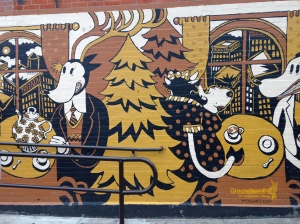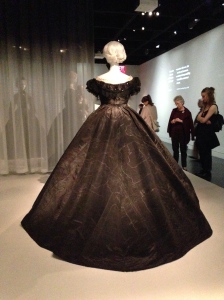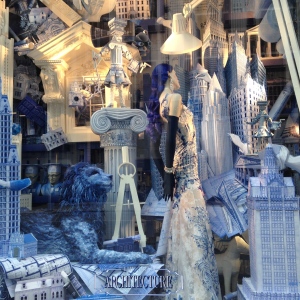During the three weeks I spent in New York City, I experienced many levels of inspiration and authenticity amongst a wide spectrum of creative industries. In this final entry I aim to recognize and reflect on my experiences as forms of immersive learning and identify these encounters with my fashion discipline and future career goals. Furthermore I will summarise my opinion of how and why New York City is a creative hub for artists.
Before travelling to New York I undertook research through a multitude of platforms. As part of this unit I was required to formally source literature on New York, in particular the Garment District, in addition to attending a number of presentations. Secondly, I initiated personal research through travel books and magazines and thirdly, I held personal preconceptions of New York formed by popular culture initiated by television shows, movies and photographs. Through this process I conceived a vision of what I expected the city to be. Only until actually being in the city and interacting with the culture was I able to fully experience what I had read, seen and heard. This notion can be referred to as immersive learning, whereby “A methodology in which the researcher seeks to observe events and the behaviour of people by taking part in the activity him- or herself. The idea underpinning this approach is that to fully understand a community or activity, rather than interviewing people or observing from a distance, one has to become a member of the community and perform an activity” (Castree, Kitchin and Rogers, 2013, 362). This definition perfectly summaries my time in the city as I began to interact with it through its various facilities and spaces just as any New Yorker would.
Although my previous entries were specifically tailored to my discipline in fashion, the creativity was abundant through a mass of diverse platforms. I witnessed dance, music, television production, landscaping, architecture, visual art, historical displays, busking, sporting events, local people, theatre and live concerts all engrained with an extremely high level of creativity. For some of these expressions I found the creativity was rather unexpected in comparison to others. For example, when attending an art gallery such as the Solomon R. Guggenheim Museum I held an assumption that it would entail a strong creative presence. On the other hand, it was only when attending the Chelsea Highline that I learnt about the way in which the site was designed, and how the original tracks were thoughtfully entwined with the vegetation that I understood how creative landscaping and architecture could be, from what I once presumed was mostly a logical practise. A similar instance occurred at the Natural Museum of History. What I expected to be an informative and artefact based display was turned into a very visual experience by the copious and extravagant exhibits and dioramas that completely enhanced my experience as a visual learner. Moreover, the beautiful fact of New York is that creativity does not need to be sought; it has a mysterious way of unexpectedly appearing even in the most unlikely place.
With such an abundance of art, talent, inspiration and individuality it is unsurprising that New York City is constantly labelled as a metropolitan hub for creative culture. In many of my posts I compared New York to my home city Brisbane, Australia. For a number of reasons I find this comparison interesting and would like to draw on this idea further. One of the major factors that I believe hinders Brisbane, and supports New York is wealth that can be inserted into the creative industries sector to financially sustain its growth. Fortunately, New York celebrates the artists that emerge from their city and thus the creative industries are continually contributing to the city’s economy and creating jobs at an increasing percentage each year (Keegan et al. 2005). Fashion historian and scholar Elizabeth Currid (2006, 331) said, “From fashion designers to film directors to musicians, New York’s greatest strength is in its ability to harness its artistic talents such that they contribute greatly to both the local culture and economy and the global marketplace”. Whereas, Brisbane relies on the support of governments that are unable to facilitate high levels of expenditure. In addition to private funding, universities in New York cater to the community by providing exhibits to encourage a creative culture. A fine example I witnessed at the Fashion Institute of Technology and is something I believe QUT could take on board, even to a much smaller scale and across all industries in an attempt to provide the public with a creative engagement.
After completing my studies at QUT with a bachelor of Business (Marketing)/ Creative Industries (Fashion) my career goal is to work as a marketer for a fashion house. After visiting New York City I am overwhelmed with the amount of choice and capacity available for this type of career. With only one year left to graduate I was feeling somewhat deflated about the prospects of my future career before taking this study tour. However, upon entering the city I discovered so many established local designers including household names Ralph Lauren and Calvin Klein resided head quarters in this city, each made up of a vast team of marketers. Requiring individuality and creativity, it is essential that I be surrounded by inspiration both directly and indirectly to enhance my career. In my opinion, New York supplies these inspirations better than any other city I have travelled to including fashion capitals London, Paris and Milan. After experiencing the city as a whole I am truly excited to know that there are plenty of opportunities awaiting. It is safe to say that experiencing this level of creativity has not only inspired me to continue working hard in my studies but to also begin perusing the companies I would like to work for in a post graduate position. This subject was one that cannot compare to any others that I have completed. I would describe it as a course summary in that it related to so many subjects I have taken and through physical experience I was able to practice a greater understanding of taught theory into these learning opportunities. It has provided me with a new perspective on learning and therefore I intend to be more open to unexpected forms of creativity and trust that I can involve these inspirations into my own work.
Bibliography:
Aldenton, Samantha. 2014.” Supermodels give Moschino campaign fast food fix.” Accessed December 20, 2014. http://www.wgsn.com.ezp01.library.qut.edu.au/content/board_viewer/#/54556/page/1
Castree, Noel, Rob Kitchin and Alisdair Rogers. 2013. “Immersive Learning.” In A Dictionary of Human Geography. Oxford: Oxford University Press.
Currid, Elizabeth. 2006. “New York as a Global Creative Hub: A Competitive Analysis of Four Theories on World Cities.” Economic Development Quarterly 20 (4): 330-350.
Fashion Institute of Technology. 2014. “Museum.” Accessed December 4, 2014. http://www.fitnyc.edu/museum.asp
Keegan, Robin, Neil Kleiman, Beth Seigel and Michael Kane. 2005. Creative New York. Accessed September 5, 2014. http://nycfuture.org/pdf/Creative_New_York.pdf
New York City Ballet. 2014. “Fun Facts.” Accessed December 1, 2014. http://www.nycballet.com/Season-Tickets/Nutcracker-Additional/Fun-Facts.aspx




